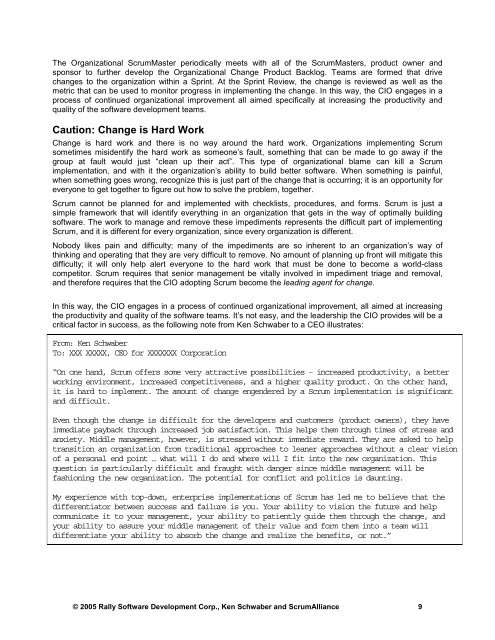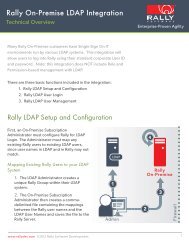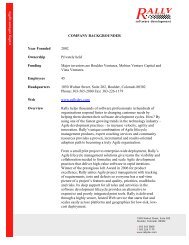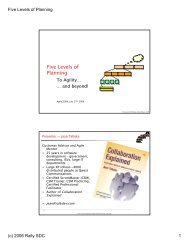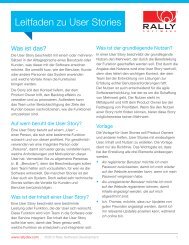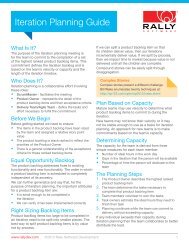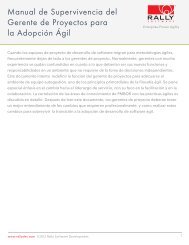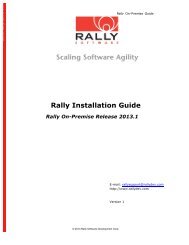A CIO's Playbook for Adopting the Scrum Method of ... - Rally Software
A CIO's Playbook for Adopting the Scrum Method of ... - Rally Software
A CIO's Playbook for Adopting the Scrum Method of ... - Rally Software
Create successful ePaper yourself
Turn your PDF publications into a flip-book with our unique Google optimized e-Paper software.
The Organizational <strong>Scrum</strong>Master periodically meets with all <strong>of</strong> <strong>the</strong> <strong>Scrum</strong>Masters, product owner andsponsor to fur<strong>the</strong>r develop <strong>the</strong> Organizational Change Product Backlog. Teams are <strong>for</strong>med that drivechanges to <strong>the</strong> organization within a Sprint. At <strong>the</strong> Sprint Review, <strong>the</strong> change is reviewed as well as <strong>the</strong>metric that can be used to monitor progress in implementing <strong>the</strong> change. In this way, <strong>the</strong> CIO engages in aprocess <strong>of</strong> continued organizational improvement all aimed specifically at increasing <strong>the</strong> productivity andquality <strong>of</strong> <strong>the</strong> s<strong>of</strong>tware development teams.Caution: Change is Hard WorkChange is hard work and <strong>the</strong>re is no way around <strong>the</strong> hard work. Organizations implementing <strong>Scrum</strong>sometimes misidentify <strong>the</strong> hard work as someone’s fault, something that can be made to go away if <strong>the</strong>group at fault would just “clean up <strong>the</strong>ir act”. This type <strong>of</strong> organizational blame can kill a <strong>Scrum</strong>implementation, and with it <strong>the</strong> organization’s ability to build better s<strong>of</strong>tware. When something is painful,when something goes wrong, recognize this is just part <strong>of</strong> <strong>the</strong> change that is occurring; it is an opportunity <strong>for</strong>everyone to get toge<strong>the</strong>r to figure out how to solve <strong>the</strong> problem, toge<strong>the</strong>r.<strong>Scrum</strong> cannot be planned <strong>for</strong> and implemented with checklists, procedures, and <strong>for</strong>ms. <strong>Scrum</strong> is just asimple framework that will identify everything in an organization that gets in <strong>the</strong> way <strong>of</strong> optimally buildings<strong>of</strong>tware. The work to manage and remove <strong>the</strong>se impediments represents <strong>the</strong> difficult part <strong>of</strong> implementing<strong>Scrum</strong>, and it is different <strong>for</strong> every organization, since every organization is different.Nobody likes pain and difficulty; many <strong>of</strong> <strong>the</strong> impediments are so inherent to an organization’s way <strong>of</strong>thinking and operating that <strong>the</strong>y are very difficult to remove. No amount <strong>of</strong> planning up front will mitigate thisdifficulty; it will only help alert everyone to <strong>the</strong> hard work that must be done to become a world-classcompetitor. <strong>Scrum</strong> requires that senior management be vitally involved in impediment triage and removal,and <strong>the</strong>re<strong>for</strong>e requires that <strong>the</strong> CIO adopting <strong>Scrum</strong> become <strong>the</strong> leading agent <strong>for</strong> change.In this way, <strong>the</strong> CIO engages in a process <strong>of</strong> continued organizational improvement, all aimed at increasing<strong>the</strong> productivity and quality <strong>of</strong> <strong>the</strong> s<strong>of</strong>tware teams. It’s not easy, and <strong>the</strong> leadership <strong>the</strong> CIO provides will be acritical factor in success, as <strong>the</strong> following note from Ken Schwaber to a CEO illustrates:From: Ken SchwaberTo: XXX XXXXX, CEO <strong>for</strong> XXXXXXX Corporation“On one hand, <strong>Scrum</strong> <strong>of</strong>fers some very attractive possibilities – increased productivity, a betterworking environment, increased competitiveness, and a higher quality product. On <strong>the</strong> o<strong>the</strong>r hand,it is hard to implement. The amount <strong>of</strong> change engendered by a <strong>Scrum</strong> implementation is significantand difficult.Even though <strong>the</strong> change is difficult <strong>for</strong> <strong>the</strong> developers and customers (product owners), <strong>the</strong>y haveimmediate payback through increased job satisfaction. This helps <strong>the</strong>m through times <strong>of</strong> stress andanxiety. Middle management, however, is stressed without immediate reward. They are asked to helptransition an organization from traditional approaches to leaner approaches without a clear vision<strong>of</strong> a personal end point … what will I do and where will I fit into <strong>the</strong> new organization. Thisquestion is particularly difficult and fraught with danger since middle management will befashioning <strong>the</strong> new organization. The potential <strong>for</strong> conflict and politics is daunting.My experience with top-down, enterprise implementations <strong>of</strong> <strong>Scrum</strong> has led me to believe that <strong>the</strong>differentiator between success and failure is you. Your ability to vision <strong>the</strong> future and helpcommunicate it to your management, your ability to patiently guide <strong>the</strong>m through <strong>the</strong> change, andyour ability to assure your middle management <strong>of</strong> <strong>the</strong>ir value and <strong>for</strong>m <strong>the</strong>m into a team willdifferentiate your ability to absorb <strong>the</strong> change and realize <strong>the</strong> benefits, or not.”© 2005 <strong>Rally</strong> S<strong>of</strong>tware Development Corp., Ken Schwaber and <strong>Scrum</strong>Alliance 9


